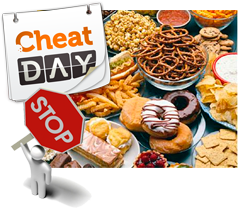
Donuts, ice cream, candy, popcorn, and pizza -- yum.
But, is there a time and place to eat these foods? A lot of people argue these foods are acceptable for a cheat day, because they boost your fat-burning hormones (like leptin and adiponectin).
While I won't argue this fact, I thought it important to
discuss the pro's and con's of eating these so-called 'foods':
So, my suggestion is to weigh the pro's and con's for yourself. Personally, here's how I 'now' handle a cheat day:





For a lot of people, this is tough to imagine. It used to be for me, too, so don't feel you have to make overnight changes; I certainly didn't.
But, in the end, food is a fuel source, so it's best to view it that way. The goal of eating is to provide us with energy. The goal of a workout program is to make us healthy. Secondarily, we lose weight, get lean, and get muscular.
When you switch around your priorities to 'health optimization' first, and 'aesthetics' second, it gets a lot easier. Your body is your temple, so treat it accordingly.
I've seen too many people suffer from food addiction and unhealthy eating. Most people regret their decisions when it's too late... and they suffer from Diabetes, Alzheimer's, cancer, stroke, heart disease, inflammatory disease, anxiety, or depression. That sucks, and I don't want it for you.
Now, let's talk about how to adapt your workouts, based upon the decisions you make. After all, you are free to make your own decisions, and we are here to guide you to the best of our ability, independent of the choices you make:
The "guilty-pleasure" cheat day protocol (includes 'fake foods'):



 Pec Major Mobility Stretch - Left Side
Pec Major Mobility Stretch - Left Side

 Pec Major Mobility Stretch - Right Side
Pec Major Mobility Stretch - Right Side

 Pec Minor Mobility Stretch - Left Side
Pec Minor Mobility Stretch - Left Side

 Pec Minor Mobility Stretch - Right Side
Pec Minor Mobility Stretch - Right Side

 Sidelying Hip Flexor Stretch - Left Side
Sidelying Hip Flexor Stretch - Left Side

 Sidelying Hip Flexor Stretch - Right Side
Sidelying Hip Flexor Stretch - Right Side

 Rotational Pivot Squats
Rotational Pivot Squats

 Lift/Reverse Lift
Lift/Reverse Lift

 Chop/Reverse Chop
Chop/Reverse Chop

 Spider Plank
Spider Plank

The "health optimization" cheat day protocol (includes higher fat, sugar, and carb intake, but from naturally occurring foods):




As you can see, there is substantially less work to be done on a 'health optimization' cheat day than there is on a 'guilty pleasure' cheat day. Not only does your workout last for less time, but it is much more reasonable. This means you'll spend less time exercising, but also have a lower chance of injury.
Injuries tend to correlate to cheat days, or the very next day. When you over-eat, and it's fake-food instead of real-food, inflammation interferes with coordination, muscle control, and strength. This means, if your workout is before you eat, you'll be fine the day of your cheat day, but the days after are more dangerous; conversely, if you're eating before you exercise, you may have more inherent risk the day of your workout and for a couple days afterward.
When a cheat day workout is done properly, you'll experience EPOC, or excess post-exercise oxygen consumption. Effectively, this is what allows you to burn calories for up to 48-72 hours after a workout. Thinking about it simply, when you push to your lactate threshold, or the last good rep, your body inflames, tiny muscle tears occur, and your body burns calories to repair itself.
If you add inflammation -- from eating -- to exercise-baseed inflammation, the cumulative effect is A LOT of swelling. Basically, this swelling puts pressure on tiny nerve receptors, interferes with muscle signaling, and results in a loss of coordination, strength, and balance. You lose the effect of future workouts because of your decisions today, but you're still on the right track from a hormonal standpoint.
With a 'health optimization' cheat day, you'll still want to reach your lactate threshold, create EPOC, and create the need for repair in days to come. However, you won't be inflamed due to the foods you eat, so the cumulative effect is that you're balancing inflammation through exercise with an optimized body ready to handle it. If you notice you're particularly sore the next day, take it easy a bit, go through your workout more slowly, but you won't have to worry about a serious increase to your risk of injury.
Plus, your body won't be prioritizing organ repair over fat loss, so you'll be more in alignment with your goals.
Regardless of your choice, as I certainly understand both perspectives, please know it's important you exercise with proper form and design your workouts for success.
If you'd like to see video demonstrations of every exercise listed above, and/or have help creating turnkey workouts -- that help eliminate excess calories and move you forward with your goals -- simply switch Create My Workout to 'overeating mode', and get started right away. If you don't have access, click below to get in Create My Workout.
Besides, if you get even half the results of our other clients, you won't be sorry. Go ahead and click 'activate my membership' below to get started right away: (*results may vary)
